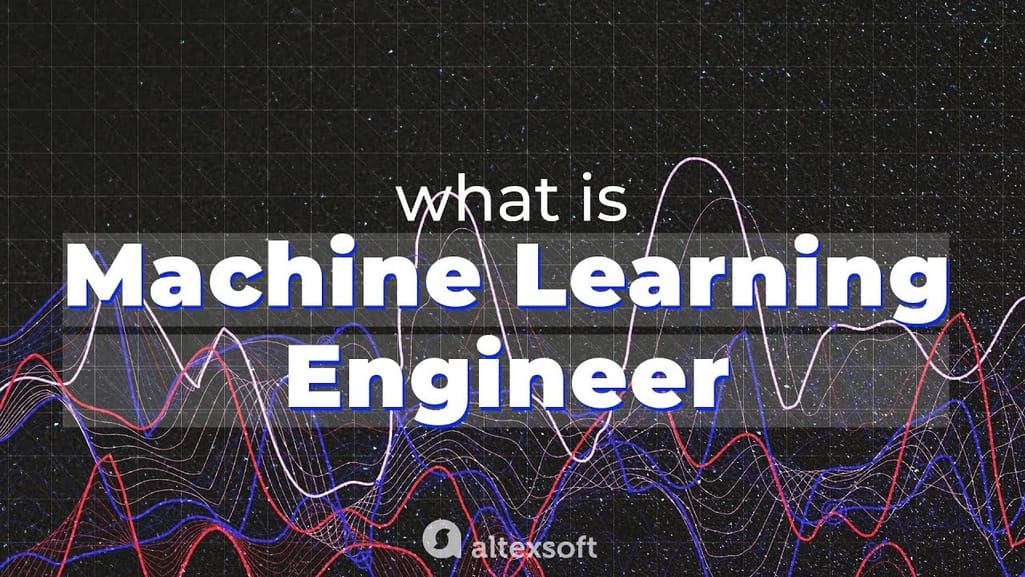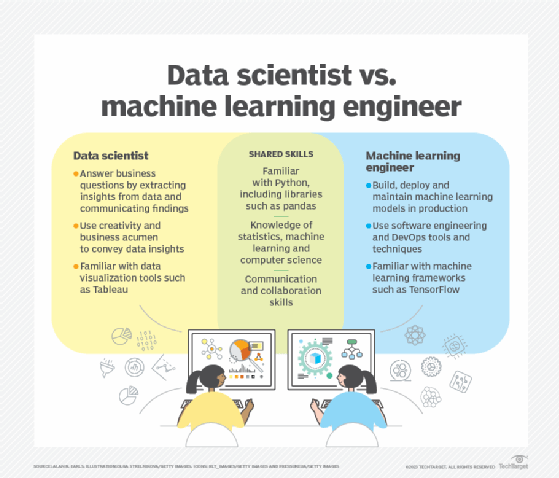All Categories
Featured
Table of Contents
- – Some Ideas on Machine Learning (Ml) & Artifici...
- – Not known Details About How To Become A Machin...
- – Some Ideas on Advanced Machine Learning Cours...
- – The 10-Minute Rule for Machine Learning Onlin...
- – The smart Trick of How To Become A Machine L...
- – Some Known Details About Machine Learning Cr...
- – The Of How To Become A Machine Learning Engi...
Some people believe that that's dishonesty. Well, that's my entire occupation. If somebody else did it, I'm going to use what that person did. The lesson is putting that apart. I'm compeling myself to think through the possible options. It's more concerning eating the content and attempting to apply those ideas and less regarding finding a library that does the job or searching for somebody else that coded it.
Dig a little bit deeper in the math at the beginning, simply so I can construct that foundation. Santiago: Lastly, lesson number seven. I do not believe that you have to recognize the nuts and screws of every algorithm before you utilize it.
I have actually been making use of semantic networks for the lengthiest time. I do have a sense of exactly how the gradient descent functions. I can not explain it to you now. I would certainly need to go and check back to actually obtain a far better instinct. That does not imply that I can not resolve things utilizing neural networks? (29:05) Santiago: Trying to force people to believe "Well, you're not going to achieve success unless you can describe every solitary information of how this works." It goes back to our sorting instance I believe that's simply bullshit suggestions.
As an engineer, I've dealt with many, several systems and I've used numerous, several things that I do not comprehend the nuts and bolts of just how it works, even though I recognize the impact that they have. That's the final lesson on that particular string. Alexey: The funny thing is when I think of all these collections like Scikit-Learn the formulas they make use of inside to implement, for instance, logistic regression or something else, are not the exact same as the formulas we examine in maker learning courses.
Some Ideas on Machine Learning (Ml) & Artificial Intelligence (Ai) You Need To Know
So even if we attempted to learn to get all these essentials of maker understanding, at the end, the formulas that these collections make use of are various. Right? (30:22) Santiago: Yeah, absolutely. I assume we require a lot much more pragmatism in the sector. Make a great deal more of an effect. Or concentrating on delivering worth and a little much less of purism.

Incidentally, there are 2 various courses. I generally speak to those that wish to work in the market that wish to have their impact there. There is a path for researchers and that is completely various. I do not dare to discuss that due to the fact that I do not recognize.
Right there outside, in the industry, pragmatism goes a lengthy way for certain. (32:13) Alexey: We had a comment that stated "Really feels more like inspirational speech than talking concerning transitioning." Maybe we must change. (32:40) Santiago: There you go, yeah. (32:48) Alexey: It is an excellent inspirational speech.
Not known Details About How To Become A Machine Learning Engineer [2022]
One of the things I wanted to ask you. First, allow's cover a pair of points. Alexey: Allow's begin with core tools and frameworks that you require to discover to really shift.
I recognize Java. I know SQL. I recognize just how to use Git. I understand Bash. Perhaps I know Docker. All these points. And I become aware of artificial intelligence, it appears like a trendy point. So, what are the core devices and frameworks? Yes, I viewed this video and I obtain persuaded that I don't require to obtain deep right into mathematics.
Santiago: Yeah, absolutely. I think, number one, you ought to begin finding out a little bit of Python. Since you currently know Java, I do not think it's going to be a huge transition for you.
Not since Python is the same as Java, yet in a week, you're gon na get a lot of the distinctions there. Santiago: Then you obtain specific core devices that are going to be made use of throughout your whole profession.
Some Ideas on Advanced Machine Learning Course You Should Know
That's a library on Pandas for data control. And Matplotlib and Seaborn and Plotly. Those three, or among those 3, for charting and presenting graphics. You get SciKit Learn for the collection of maker learning algorithms. Those are devices that you're going to need to be using. I do not suggest just going and learning more about them unexpectedly.
Take one of those training courses that are going to begin introducing you to some problems and to some core concepts of device discovering. I don't keep in mind the name, but if you go to Kaggle, they have tutorials there for free.
What's good concerning it is that the only demand for you is to understand Python. They're mosting likely to present an issue and tell you how to make use of decision trees to address that certain issue. I assume that procedure is extremely effective, because you go from no equipment finding out background, to understanding what the issue is and why you can not resolve it with what you recognize today, which is straight software application design practices.
The 10-Minute Rule for Machine Learning Online Course - Applied Machine Learning
On the other hand, ML designers specialize in building and deploying artificial intelligence versions. They concentrate on training models with information to make predictions or automate tasks. While there is overlap, AI designers deal with more varied AI applications, while ML engineers have a narrower focus on maker discovering formulas and their sensible implementation.

Equipment discovering engineers focus on establishing and deploying equipment learning versions into production systems. On the other hand, data scientists have a wider role that consists of information collection, cleaning, exploration, and structure models.
As organizations progressively take on AI and maker knowing technologies, the need for competent professionals grows. Device knowing engineers work on sophisticated jobs, contribute to technology, and have affordable wages.
ML is essentially different from standard software program growth as it focuses on training computers to discover from data, as opposed to programming explicit rules that are performed methodically. Uncertainty of outcomes: You are probably made use of to composing code with predictable outputs, whether your feature runs when or a thousand times. In ML, nonetheless, the outcomes are much less specific.

Pre-training and fine-tuning: Just how these models are trained on vast datasets and after that fine-tuned for details jobs. Applications of LLMs: Such as message generation, sentiment evaluation and info search and access. Papers like "Attention is All You Required" by Vaswani et al., which presented transformers. On-line tutorials and programs concentrating on NLP and transformers, such as the Hugging Face course on transformers.
The smart Trick of How To Become A Machine Learning Engineer (With Skills) That Nobody is Discussing
The capability to handle codebases, merge changes, and fix disputes is equally as important in ML development as it remains in traditional software program tasks. The abilities established in debugging and testing software applications are highly transferable. While the context might change from debugging application reasoning to recognizing issues in data handling or model training the underlying concepts of methodical investigation, theory testing, and repetitive refinement are the same.
Device discovering, at its core, is greatly dependent on data and likelihood theory. These are vital for understanding exactly how formulas learn from data, make predictions, and review their efficiency.
For those curious about LLMs, a thorough understanding of deep understanding styles is helpful. This includes not just the mechanics of neural networks but additionally the design of particular models for different use situations, like CNNs (Convolutional Neural Networks) for image processing and RNNs (Frequent Neural Networks) and transformers for consecutive data and all-natural language processing.
You need to understand these problems and find out techniques for identifying, alleviating, and connecting regarding prejudice in ML designs. This consists of the possible effect of automated decisions and the honest effects. Several designs, particularly LLMs, need considerable computational resources that are frequently provided by cloud systems like AWS, Google Cloud, and Azure.
Structure these skills will not just facilitate an effective shift right into ML yet also guarantee that designers can contribute effectively and properly to the development of this dynamic area. Theory is important, however nothing defeats hands-on experience. Start dealing with tasks that allow you to use what you've discovered in a sensible context.
Develop your projects: Beginning with easy applications, such as a chatbot or a message summarization device, and gradually enhance complexity. The field of ML and LLMs is swiftly advancing, with brand-new developments and innovations emerging frequently.
Some Known Details About Machine Learning Crash Course
Sign up with areas and online forums, such as Reddit's r/MachineLearning or area Slack channels, to discuss concepts and get advice. Attend workshops, meetups, and meetings to attach with other professionals in the area. Add to open-source projects or compose post regarding your discovering trip and projects. As you acquire know-how, start seeking possibilities to incorporate ML and LLMs right into your work, or look for brand-new duties concentrated on these innovations.

Prospective usage situations in interactive software application, such as referral systems and automated decision-making. Recognizing uncertainty, basic statistical actions, and probability distributions. Vectors, matrices, and their function in ML formulas. Error minimization methods and gradient descent discussed simply. Terms like design, dataset, features, labels, training, reasoning, and recognition. Data collection, preprocessing strategies, model training, analysis procedures, and deployment considerations.
Choice Trees and Random Forests: Instinctive and interpretable designs. Matching trouble kinds with ideal models. Feedforward Networks, Convolutional Neural Networks (CNNs), Reoccurring Neural Networks (RNNs).
Data flow, improvement, and attribute design approaches. Scalability concepts and efficiency optimization. API-driven strategies and microservices integration. Latency management, scalability, and version control. Continuous Integration/Continuous Deployment (CI/CD) for ML workflows. Version tracking, versioning, and performance tracking. Detecting and attending to changes in version performance with time. Resolving efficiency bottlenecks and source management.
The Of How To Become A Machine Learning Engineer - Exponent

You'll be introduced to three of the most relevant parts of the AI/ML self-control; supervised discovering, neural networks, and deep knowing. You'll realize the differences between traditional programming and machine knowing by hands-on development in monitored understanding before constructing out complicated distributed applications with neural networks.
This course serves as an overview to maker lear ... Program More.
Table of Contents
- – Some Ideas on Machine Learning (Ml) & Artifici...
- – Not known Details About How To Become A Machin...
- – Some Ideas on Advanced Machine Learning Cours...
- – The 10-Minute Rule for Machine Learning Onlin...
- – The smart Trick of How To Become A Machine L...
- – Some Known Details About Machine Learning Cr...
- – The Of How To Become A Machine Learning Engi...
Latest Posts
The 5-Second Trick For Machine Learning Devops Engineer
How To Pass The Interview For Software Engineering Roles – Step-by-step Guide
Some Known Details About 21 Best Machine Learning Courses To Build New Skills In ...
More
Latest Posts
The 5-Second Trick For Machine Learning Devops Engineer
How To Pass The Interview For Software Engineering Roles – Step-by-step Guide
Some Known Details About 21 Best Machine Learning Courses To Build New Skills In ...